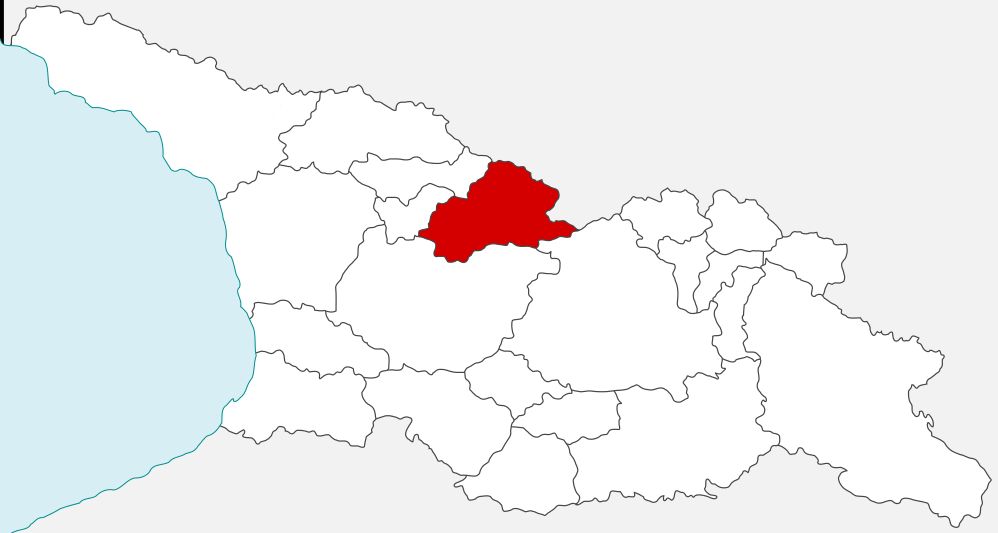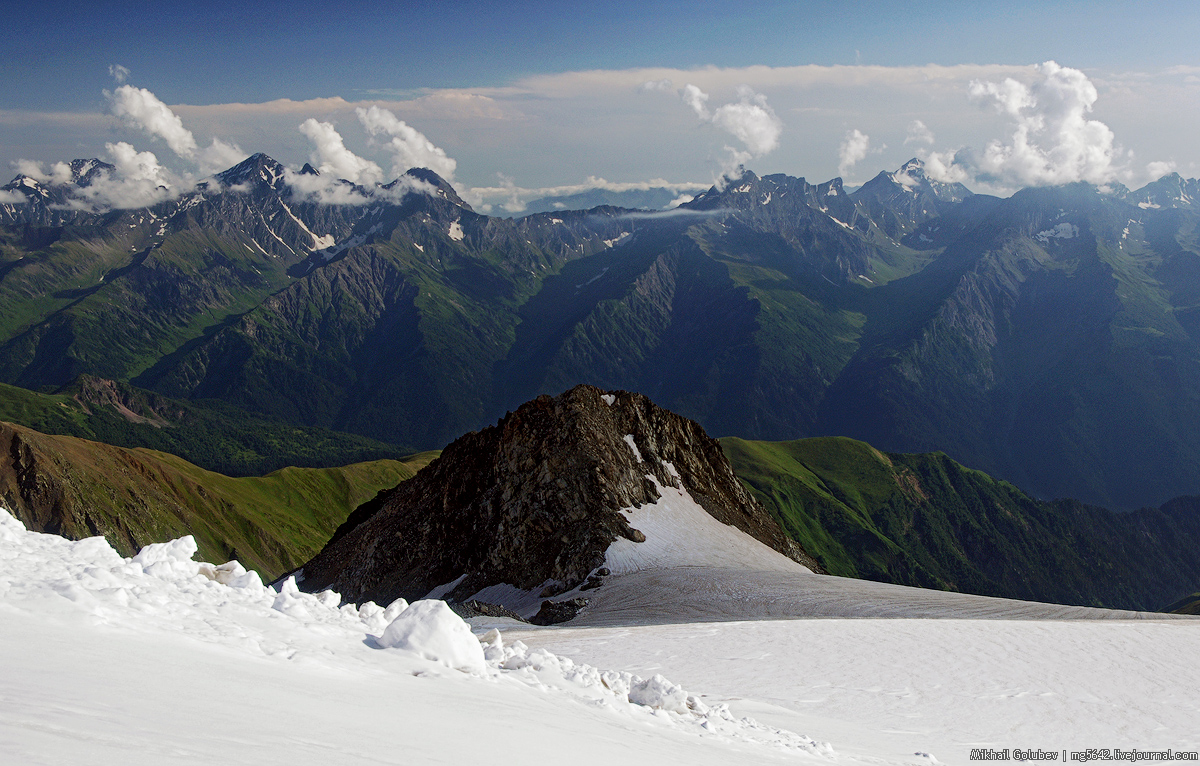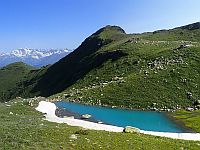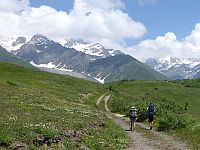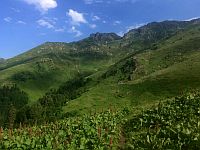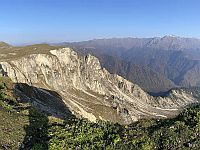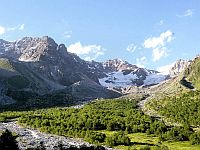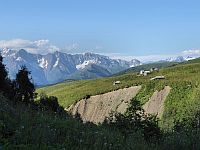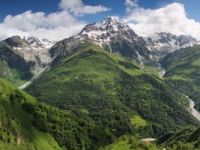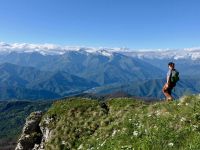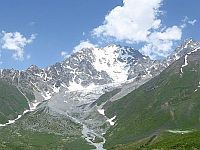Racha
Racha is another mountainous region in Greater Caucasus. Unlike other areas, it lacks major tourist attractions and offers "only" unspoiled mountains and forests, mineral springs, caves, lakes and great food and wine. Therefore it's often overlooked by foreign tourists, who are trying to pack as many "highlights" as possible into their 1- or 2-week itineraries. But Georgians, who don´t have to rush are well aware of beauty of this sparsely populated region and form the majority of visitors.
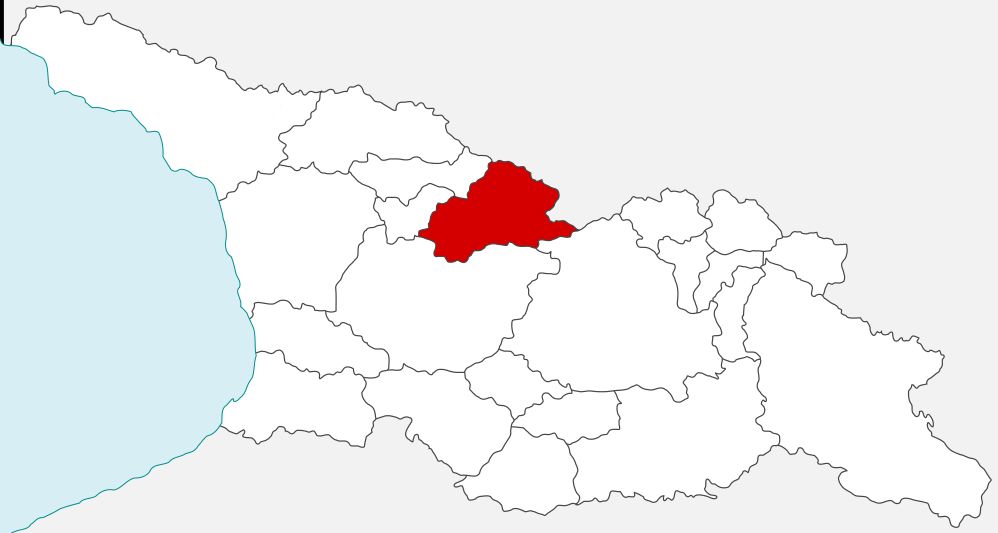
Racha province is tucked between Svaneti to the west, Russia to the north and South Ossetia breakway republic to the east. Symbolic backbone of the region is Rioni river, largest river of western Georgia. Capital of the province is Ambrolauri with population of 2500.
Racha is definitely a beautiful, calm and very atmospheric region, but from trekkers perspective it's not as interesting as lets say Svaneti or Khevsureti. There are just a few trekking trails - "extreme" crossing to Svaneti, beautiful 2-day trip to Udziro lake, newly open trail to Notzara huts and a few shorter trails. It's more suitable for wanderers, "explorers" and experienced trekkers. Major problem is also a close proximity of South Ossetia (Samachablo), which limits the list of available places and independent trekker should be also prepared for greater attention from border guards.
How to get to Racha:
Best place to start yours trip to Racha is a bus station in Kutaisi - buses to Ambrolauri should leave from bus terminal at Mkheidze below Bagrati cathedral at 10:00 am.
and 2:00 pm (better confirm it with taxi driver). Marshrutka going to Oni located higher in the Rioni valley leaves daily from same terminal at 9:00 am.
There are also several daily marshrutkas to Oni from Didube station in Tbilisi, which tend be leave between 8 and 9 am. and the price of ticket is 30 GEL.

Mountains of Racha (by Mikhail Golubev)
Nikortsminda cathedral
Nikortsminda cathedral is one of the most important architectural monuments of medieval Georgia. It was built during the reign of King Bagrat III. in years 1010-1014.
Its architects used quite unusual design - the interior of the cathedral is hexagonal and all sides with the exception of the entrance are flanked by apses.
Interior is decorated with paintings depicting saints, mass scenes, and various animals.
Exterior of the cathedral is decorated with stone carvings. Each of them is related to the theme of the divine greatness of Christ.
Cathedral lies in the village of the same name a bit southwest of Ambrolauri.
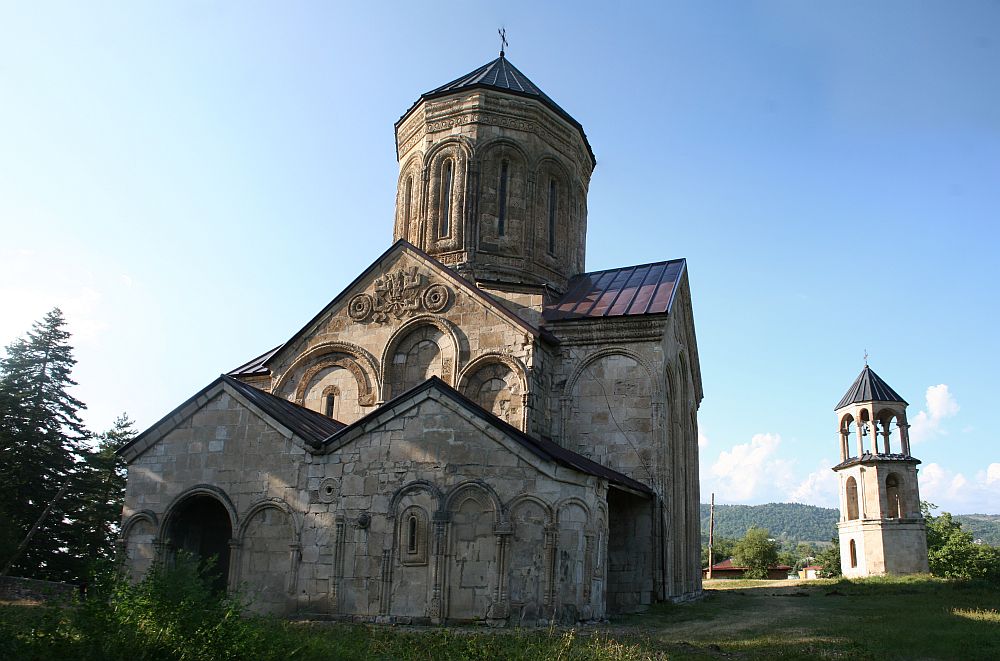
Nikortsminda cathedral
Chiatura
When Stalin was in Kutaisi, the miners of nearby Chiatura appealed to him. Astride snow-peaked mountains, Chiatura was growing fast: this Russia’s biggest manganese mine supplied around 60% of the world’s production. Dominated by a lunar landscape of ore heaps, its 3,700 “black-skinned” workers toiled eighteen-hour days in choking dust for paltry salaries. Lacking baths and even housing, miners slept down in the mines. ’Animals, wrote Kote Tsintsadze, a gunman who was Stalin’s future bank-robbery supremo, “lived better than Chiatura workers.”’
Chiatura is a mining town lying in the Imereti region of Georgia, where Josif Stalin started his revolutionary career.
During the 1905 unrest, he was able to take control of the city and turned it into only real bolshevik stronghold in Georgia -
mainly because of abysmal working conditions of local miners.
Stalin eventually rewarded “his city”. Shortly before his death, he ordered a construction of brand new cable car system to enable faster transport of workers around the valley and into the mines.
Chiatura was meant to be a “miner’s paradise”, the state invested a lot of money into its infrastructure (theater, baths, pioneer’s palace).
But nothing lasts forever. Chiatura was heavily hit by the dissolution of the Soviet Union and the following deindustrialization. Nowadays, the city is just a shadow of its former self.
While the city is nowadays well-known amongst more adventurous travelers, it still has a lot of untapped potential.
The combination of brutalist architecture and stunning nature plus cable cars serving as a public transport make it the unique destination.
Tourist infrastructure is still lacking, but it should improve in next few years and locals are slowly becoming aware of new opportunities in the tourist industry.
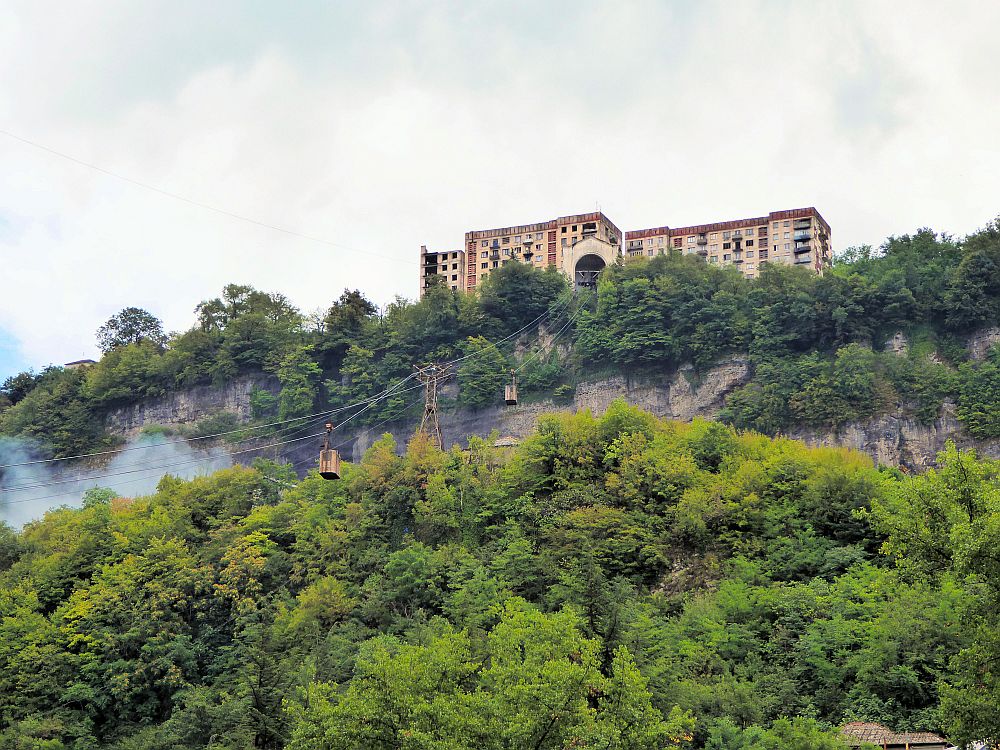
Chiatura
Katskhi pillar
Katshi pillar is 40 meters tall limestone pillar lying in a proximity of Chiatura. Nowadays, it serves as a refuge of Maxim Quavtaradze, the world´s most famous stylite.
Stylites, known also as“ pillar-saints” were Christian ascetics, who lived on pillars - they believed that discomfort they suffer would bring them closer to God.
They were quite common in the early days of Byzantine empire - first known stylite was St. Simeon Stylites. From here, the practice spread also to Georgia,
as there were suitable natural conditions for this kind of mortification. Practice was abandoned in the 15th century after Georgia fell under the control of Ottoman empire.
Maxim revived the tradition in the year 1992 when he moved to the top of the pillar. He also restored the ancient chapel lying at the top of the pillar.
Nowadays, the area around pillar is quite busy as s small religious community settled here. It should be also noted that it´s not allowed to climb the pillar unless Maxim allows you to do it.
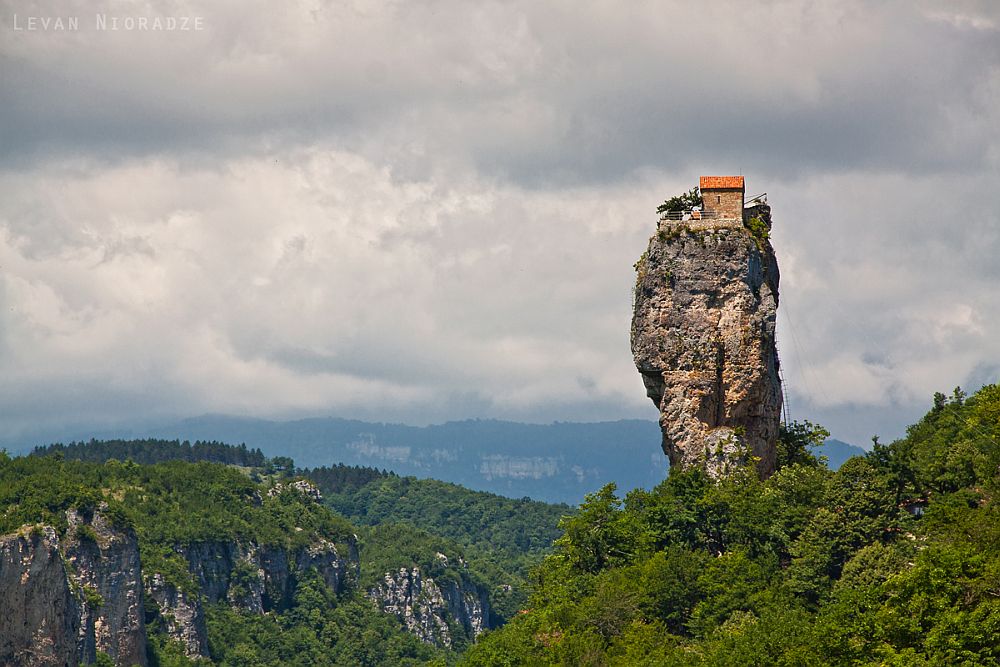
Katskhi pillar (by Levan Nioradze)
Trek to the Udziro lake
This trek would be way more popular if it didn’t lie at the very end of Racha. It climbs to the small alpine lake lying at the elevation of 2800m - in a good weather, there is a great view of Caucasus panorama.
- Duration: 2 Days
- Difficulty: Hard
From Chiora to Notsara valley
The great hike which follows an old dirt road climbing from the Chiora village to the upper Notsaruli valley. The walk is not that difficult and offers great 360° views of surrounding mountains.
- Duration: 1 Day
- Difficulty: Moderate
Trekking in Akhalchala reserve
Probably the best trek in the Akhalchala area is the loop between villages Kulbaki and Zeda Lukhvano. It visits climatic resort of the same name, Green lake and in-between climbs to almost 3000m, providing fantastic views of surrounding mountains.
- Duration: 3 Days
- Difficulty: Moderate/Hard
Crossing of the Askhi massif
Askhi Massif is an outstanding rock formation with breath-taking cliffs, a seemingly endless open range on the plateau, and great views of the surrounding ridges.
- Duration: 2 Days
- Difficulty: Moderate/Hard
Hike to Buba glacier
Classic hike climbing from Shovi resort onto the small ridge which provides nice views of Buba glacier. The actual glacier is a bit of a letdown, but the surrounding mountains are really impressive.
- Duration: 7 hours
- Difficulty: Moderate
Crossing of Lechkhumi range
This trek starts by the Shkedi village in the Lower Svaneti and crosses Lechkhumi ridge to the south by Kelida pass (3036m), close to the Chutkharo mountain. Then it descends into Sadmeli village in Lower Racha
- Duration: 2/3 Days
- Difficulty: Moderate/Hard
Trekking from Svaneti to Racha
This beautiful, but very demanding trek takes you to some of the most remote parts of Caucasus. It follows the old road, which once connected Zeskho village in Svaneti with Ghebi village in Racha, but fell into disrepair long time ago.
- Duration: 3 days
- Difficulty: Very Hard
Trek fromImereti to Racha
This spectacular yet little-known trek highlights stark changes in Georgian geography as it weaves through thick forests and looming alpine cliffs, connecting lowlands of Imereti with the rugged highlands of Racha.
- Duration: 2-3 days
- Difficulty: Moderate/Hard
Trek to Buba and Tbilisa glaciers
A longer version of the hike to the Buba glacier. This one crosses the Buba river, traverses to the Tbilisa glacier and returns to Shovi via Mamisoni road. Pretty solid trek, though not the best around as almost half of the trail follows the dirt road.
- Duration: 2 - 3 days
- Difficulty: Moderate / Hard
